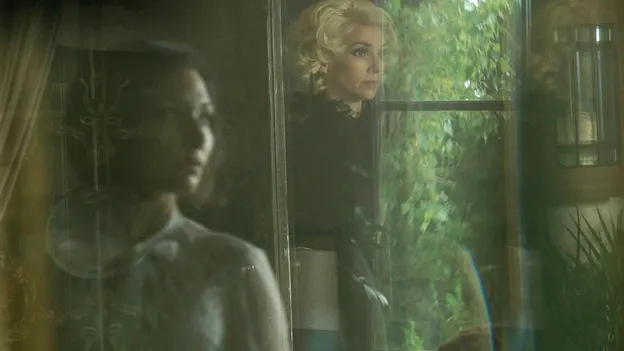Peter Strickland is quickly becoming one of the avant-garde filmmakers to watch, and his entry into this year’s “un certain regard” at the Cannes Film Festival is his best film to date. The Duke of Burgundy is a sensual romantic drama about two women in a non-specific time and place, engaging in games of punishment and pleasure. Despite a description which could suggest something pornographic, Strickland’s film is a romantic, sexy, and funny look at very real relationships that transcends sexual orientation.
When I spoke with Strickland, he was well aware of the limitations of telling a story about the love of two women as someone who might find it difficult to avoid the male gaze. This self-awareness is refreshing to observe from a director who also made an effort to avoid passing judgement on his characters, the older Cynthia (Sidse Babett Knudsen) and younger Evelyn (Chiara D’Anna), who live in what Strickland describes as a Utopia.
“I didn’t want the real world to come into play,” explains Strickland “The period and place are not specific. They have no jobs, and society doesn’t see them as lesbians, so they aren’t burdened by that judgment or need for secrecy. So it isn’t so much a lesbian or gay film, as much as it is a romance about two women in a committed relationship.” This refreshing take on a romance made me ask if the film would be different if the film had starred two men or a man and a woman. Strickland admits that would have changed the dynamics of the film completely, and that he would have never wanted to make a movie focused on those characters. “I would have been uncomfortable if the male were the dominant, because even if in reality those relationships exist, when you put it on film there are aspects you have to consider. What are you saying about gender and the role women play to men? There is a history of oppression I didn’t want to suggest with this relationship.”
By focusing on two women, Strickland was able to ultimately focus on the personalities and relationship. Although the older Cynthia plays the dominant character when they act out their game, Evelyn is really the one in charge, making the plans and setting the rules. In their roles, Knudsen and D’Anna are excellent and completely committed. As Evelyn, D’Anna is almost childlike in her delight with these games, and also like a child, often very selfish. Evelyn’s desire for play only increases as she goes further and further, despite Cynthia’s need to return to their real life. The scenes of their “real,” typical life are very necessary for the characters, in order to understand that these games are, in their relationship, an attempt by Cynthia to make Evelyn happy. Cynthia also experiences anxiety over her performances in these games, especially when she fears younger Evelyn will lose interest if she fails. Cynthia’s tearful scene over the anxiety she feels at having to “please” Evelyn is one of Strickland’s favorites, largely because of the expressive performance by Knudsen. An actress keenly aware of how to show emotions to the audience subtly, she gives a wonderful, soulful performance.
I mention that one of my favorite scenes were the quiet moments of her preparing to play the dominant role, looking like an actress in a dressing room before a theatrical performance. The thematic similarities between performance and relationships are not lost on Strickland who notes that “everyone plays roles in relationships to make their partner happy.” Directing actresses in this kind of film did make Strickland aware of some the connections between the subject matter and relationship between actor and director. “I am sometimes like Evelyn, trying to get people to play the role exactly as I want. And I’ve heard of directors who are abusive with actresses. I don’t think I’m like that, but there were moments when I was struck by the similarities. I was taping the marks I wanted Evelyn to hit as she instructs Cynthia, and thought of that. It was very strange position to be in.”
Strickland acknowledges the fact that like Cynthia, he does have some anxiety as a director because his preference for writing comes from needing outlet to express himself, while directing has helped him to overcome that tendency. As for the inspiration for a story of this kind, Strickland pulls from a very interesting inspiration: the sexploitation films of the ’60s and ’70s. He notes that while most other “overlooked” genres of the past have been given a second life in re-affirmation films (Tarantino takes some responsibility for this trend), the sexploitation films have not, because they were so firmly films showing female sexuality for the pleasure of the male gaze.
That was an aspect Strickland was deeply concerned with in the making of this film. He couldn’t ignore or pretend he wasn’t a man directing women, but he also wanted to ensure the film avoided the typical pitfalls. Awareness seems to have been key, along with focusing on the relationship first, rather making a film which is clearly just an excuse to show sex. I’m happy to say he succeeds with his ambitions, as The Duke of Burgundy makes for a great romantic watch… for anyone.
Lesley Coffin is a New York transplant from the midwest. She is the New York-based writer/podcast editor for Filmoria and film contributor at The Interrobang. When not doing that, she’s writing books on classic Hollywood, including Lew Ayres: Hollywood’s Conscientious Objector and her new book Hitchcock’s Stars: Alfred Hitchcock and the Hollywood Studio System.
Are you following The Mary Sue on Twitter, Facebook, Tumblr, Pinterest, & Google +?









Published: Jan 26, 2015 08:00 pm